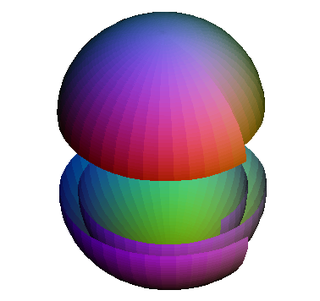In mathematics, the Bott periodicity theorem describes a periodicity in the homotopy groups of classical groups, discovered by Raoul Bott, which proved to be of foundational significance for much further research, in particular in K-theory of stable complex vector bundles, as well as the stable homotopy groups of spheres. Bott periodicity can be formulated in numerous ways, with the periodicity in question always appearing as a period-2 phenomenon, with respect to dimension, for the theory associated to the unitary group. See for example topological K-theory.
In stable homotopy theory, a branch of mathematics, Morava K-theory is one of a collection of cohomology theories introduced in algebraic topology by Jack Morava in unpublished preprints in the early 1970s. For every prime number p (which is suppressed in the notation), it consists of theories K(n) for each nonnegative integer n, each a ring spectrum in the sense of homotopy theory. Johnson & Wilson (1975) published the first account of the theories.
In mathematics, complex cobordism is a generalized cohomology theory related to cobordism of manifolds. Its spectrum is denoted by MU. It is an exceptionally powerful cohomology theory, but can be quite hard to compute, so often instead of using it directly one uses some slightly weaker theories derived from it, such as Brown–Peterson cohomology or Morava K-theory, that are easier to compute.

In the mathematical field of algebraic topology, the homotopy groups of spheres describe how spheres of various dimensions can wrap around each other. They are examples of topological invariants, which reflect, in algebraic terms, the structure of spheres viewed as topological spaces, forgetting about their precise geometry. Unlike homology groups, which are also topological invariants, the homotopy groups are surprisingly complex and difficult to compute.
In an area of mathematics called differential topology, an exotic sphere is a differentiable manifold M that is homeomorphic but not diffeomorphic to the standard Euclidean n-sphere. That is, M is a sphere from the point of view of all its topological properties, but carrying a smooth structure that is not the familiar one.
Jeffrey Henderson Smith is a former professor of mathematics at Purdue University in Lafayette, Indiana. He received his Ph.D. from the Massachusetts Institute of Technology in 1981, under the supervision of Daniel Kan, and was promoted to full professor at Purdue in 1999. His primary research interest is algebraic topology; his best-cited work consists of two papers in the Annals of Mathematics on "nilpotence and stable homotopy".
In mathematics, stable homotopy theory is the part of homotopy theory concerned with all structure and phenomena that remain after sufficiently many applications of the suspension functor. A founding result was the Freudenthal suspension theorem, which states that given any pointed space , the homotopy groups stabilize for sufficiently large. In particular, the homotopy groups of spheres stabilize for . For example,
In mathematics, the J-homomorphism is a mapping from the homotopy groups of the special orthogonal groups to the homotopy groups of spheres. It was defined by George W. Whitehead (1942), extending a construction of Heinz Hopf (1935).
The Oswald Veblen Prize in Geometry is an award granted by the American Mathematical Society for notable research in geometry or topology. It was funded in 1961 in memory of Oswald Veblen and first issued in 1964. The Veblen Prize is now worth US$5000, and is awarded every three years.

Jack Johnson Morava is an American homotopy theorist at Johns Hopkins University.
In mathematics, the Toda bracket is an operation on homotopy classes of maps, in particular on homotopy groups of spheres, named after Hiroshi Toda, who defined them and used them to compute homotopy groups of spheres in.
In mathematics, Brown–Peterson cohomology is a generalized cohomology theory introduced by Edgar H. Brown and Franklin P. Peterson (1966), depending on a choice of prime p. It is described in detail by Douglas Ravenel . Its representing spectrum is denoted by BP.
In mathematics, the chromatic spectral sequence is a spectral sequence, introduced by Ravenel (1978), used for calculating the initial term of the Adams spectral sequence for Brown–Peterson cohomology, which is in turn used for calculating the stable homotopy groups of spheres.

Michael Jerome Hopkins is an American mathematician known for work in algebraic topology.
Mark Edward Mahowald was an American mathematician known for work in algebraic topology.

Douglas Conner Ravenel is an American mathematician known for work in algebraic topology.
In mathematics, the Ravenel conjectures are a set of mathematical conjectures in the field of stable homotopy theory posed by Douglas Ravenel at the end of a paper published in 1984. It was earlier circulated in preprint. The problems involved have largely been resolved, with all but the "telescope conjecture" being proved in later papers by others. The telescope conjecture is now generally believed not to be true, though there are some conflicting claims concerning it in the published literature, and is taken to be an open problem. Ravenel's conjectures exerted influence on the field through the founding of the approach of chromatic homotopy theory.
Goro Nishida was a Japanese mathematician. He was a leading member of the Japanese school of homotopy theory, following in the tradition of Hiroshi Toda.
In mathematics, chromatic homotopy theory is a subfield of stable homotopy theory that studies complex-oriented cohomology theories from the "chromatic" point of view, which is based on Quillen's work relating cohomology theories to formal groups. In this picture, theories are classified in terms of their "chromatic levels"; i.e., the heights of the formal groups that define the theories via the Landweber exact functor theorem. Typical theories it studies include: complex K-theory, elliptic cohomology, Morava K-theory and tmf.
This is a glossary of properties and concepts in algebraic topology in mathematics.






